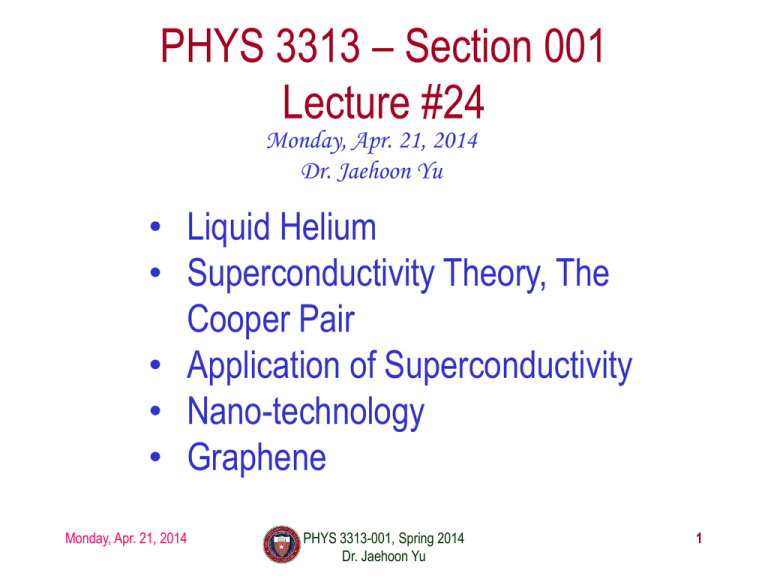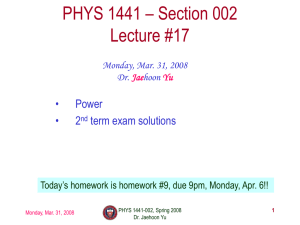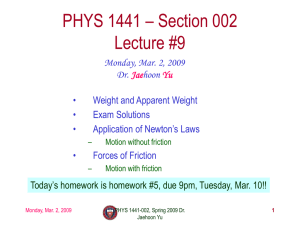Monday, Apr. 21, 2014
advertisement

PHYS 3313 – Section 001 Lecture #24 Monday, Apr. 21, 2014 Dr. Jaehoon Yu • Liquid Helium • Superconductivity Theory, The Cooper Pair • Application of Superconductivity • Nano-technology • Graphene Monday, Apr. 21, 2014 PHYS 3313-001, Spring 2014 Dr. Jaehoon Yu 1 Announcements • Reminder Homework #6 – CH7 end of chapter problems: 7, 8, 9, 12, 17 and 29 – Due on Wednesday, Apr. 23, in class • Quiz #4 – This Wednesday at the beginning of the class – Covers CH6 through what we finish today • Final exam is 11am – 1:30pm, Monday, May 5, SH103 – Comprehensive exam covering from CH1.1 to what we finish this Wednesday + appendices 3 – 7 – BYOF: one handwritten, letter size, front and back • No derivations or solutions of any problems allowed! • Reading assignments – CH10.1, 10.3 and 10.4 • Please be sure to fill out the feedback survey. • Colloquium this Wednesday at 4pm in SH101 Monday, Apr. 21, 2014 PHYS 3313-001, Spring 2014 Dr. Jaehoon Yu 2 Reminder: Research Project Report 1. Must contain the following at the minimum – Original theory or Original observation – Experimental proofs or Theoretical prediction + subsequent experimental proofs – Importance and the impact of the theory/experiment – Conclusions 2. Each member of the group writes a 10 (max) page report, including figures – 10% of the total grade – Can share the theme and facts but you must write your own! – Text of the report must be your original! – Due Mon., Apr. 28, 2014 Monday, Apr. 21, 2014 PHYS 3313-001, Spring 2014 Dr. Jaehoon Yu 3 Monday, Apr. 21, 2014 PHYS 3313-001, Spring 2014 Dr. Jaehoon Yu 4 • Research Presentations Each of the 8 research groups makes a 12+3 min presentation – – – 12min presentation + 3min Q&A All presentations must be in power point I must receive all final presentation files by 8pm, Sunday, Apr. 27 • – • The representative of the group makes the presentation followed by all group members’ participation in the Q&A session Date and time: – • No changes are allowed afterward In class Monday, Apr. 28 or in class Wednesday, Apr. 30 Important metrics – Contents of the presentation: 60% • • – – – – – Inclusion of all important points as mentioned in the report The quality of the research and making the right points Quality of the presentation itself: 15% Presentation manner: 10% Q&A handling: 10% Staying in the allotted presentation time: 5% Judging participation and sincerity: 5% Monday, Apr. 21, 2014 PHYS 3313-001, Spring 2014 Dr. Jaehoon Yu 5 Liquid Helium • Has the lowest boiling point of any element (4.2 K at 1 atmosphere pressure) and has no solid phase at normal pressure • Helium is so light, has high speed and so escapes outside of the Earth atmosphere Must be captured from underground Monday, Apr. 21, 2014 PHYS 3313-001, Spring 2014 Dr. Jaehoon Yu 6 Liquid Helium The specific heat of liquid helium as a function of temperature •The temperature at about 2.17 K is referred to as the critical temperature (Tc), transition temperature, or the lambda point. •As the temperature is reduced from 4.2 K toward the lambda point, the liquid boils vigorously. At 2.17 K the boiling suddenly stops. •What happens at 2.17 K is a transition from the normal phase to the superfluid phase. Monday, Apr. 21, 2014 PHYS 3313-001, Spring 2014 Dr. Jaehoon Yu 7 He Transition to Superfluid State T>Tc T<Tc Vessel with very fine holes that do not allow passage of normal liquid See the liquid here Boiling surface Calm surface below 2.17K Monday, Apr. 21, 2014 PHYS 3313-001, Spring 2014 Dr. Jaehoon Yu 8 Liquid Helium • The rate of flow increases dramatically as the temperature is reduced because the superfluid has a low viscosity. • Creeping film – formed when the viscosity is very low • But when the viscosity is measured through the drag on a metal surface, He behaves like a normal fluid Contradiction!! Monday, Apr. 21, 2014 PHYS 3313-001, Spring 2014 Dr. Jaehoon Yu 9 Liquid Helium • Fritz London claimed (1938) that liquid helium below the lambda point is a mixture of superfluid and normal fluid. • As the temperature approaches absolute zero, the superfluid approaches 100% superfluid. • The fraction of helium atoms in the superfluid state: æTö F = 1- ç ÷ è Tc ø 32 • Superfluid liquid helium (4He) is referred to as a BoseEinstein condensation. • 4He is a boson thus it is not subject to the Pauli exclusion principle • all particles are in the same quantum state Monday, Apr. 21, 2014 PHYS 3313-001, Spring 2014 Dr. Jaehoon Yu 10 Superconductivity • Superconductivity is characterized by the absence of electrical resistance and the expulsion of magnetic flux from the superconductor and was discovered 100 yrs ago It is characterized by two macroscopic features: • Zero resistivity – First discovered in 1911 by Onnes who achieved temperatures approaching 1 K with liquid helium. – In a superconductor the resistivity drops abruptly to zero at the critical (or transition) temperature Tc. – Superconducting behavior tends to be similar within the given column of the periodic table. – In 1956 – 1958, British physicists led by S.C. Collins established a current in a superconducting ring without a power source Monday, Apr. 21, 2014 PHYS 3313-001, Spring 2014 Dr. Jaehoon Yu 11 Superconductivity –Meissner Effect • • • • The complete expulsion of magnetic flux from within a superconductor by generating a screening current discovered in 1933 by W. Meissner and R. Oschenfeld The Meissner effect works only to the point where the critical field Bc is exceeded, and the superconductivity is lost until the magnetic field is reduced to below Bc. The critical field varies with temperature. To use a superconducting wire to carry current without resistance, there will be a limit (critical current) to the current that can be used. Monday, Apr. 21, 2014 PHYS 3313-001, Spring 2014 Dr. Jaehoon Yu 12 Superconductivity – Zero Resistivity Tc Monday, Apr. 21, 2014 PHYS 3313-001, Spring 2014 Dr. Jaehoon Yu 13 Type I and Type II Superconductors There is a lower critical field, Bc1 and an upper critical field, Bc2. Type II: Below Bc1 and above Bc2. Behave in the same manner Type I: Below and above Bc Monday, Apr. 21, 2014 PHYS 3313-001, Spring 2014 Dr. Jaehoon Yu 14 Type I and Type II Superconductors • Between Bc1 and Bc2 (vortex state), there is a partial penetration of magnetic flux although the zero resistivity is not lost. Lenz’s law: • A phenomenon from classical physics • A changing magnetic flux generates a current in a conductor in such way that the current produced will oppose the change in the original magnetic flux. Monday, Apr. 21, 2014 PHYS 3313-001, Spring 2014 Dr. Jaehoon Yu 15 Superconductivity Bardeen-Cooper-Schrieffer theory (electron-phonon interaction): 1) 2) Electrons form Cooper pairs which propagate throughout the lattice. Propagation is without resistance because the electrons move in resonance with the lattice vibrations (phonons). • How is it possible for two electrons to form a coherent pair? • Each of the two electrons experiences a net attraction toward the nearest positive ion. • Relatively stable electron pairs can be formed. The two fermions (spin ½ particles) combine to form a boson (integer spin). Then the collection of these bosons condense to form the superconducting state. Monday, Apr. 21, 2014 PHYS 3313-001, Spring 2014 Dr. Jaehoon Yu 16 Superconductivity • Considering just one of the two electrons, the propagation wave that is created by lattice deformation due to the Coulomb attraction between the electron and ions is associated with phonon transmission, and the electron-phonon resonance allows the electron to move without resistance. • The complete BCS theory predicts other observed phenomena. 1) 2) 3) An isotope effect with an exponent very close to 0.5 of mass. (M0.5Tc=constant) é æ T ö2ù It gives a critical field. Bc (T ) = Bc ( 0 ) ê1- ç ÷ ú êë è Tc ø úû Predicts that metals with higher resistivity in room temperature are better superconductors Monday, Apr. 21, 2014 PHYS 3313-001, Spring 2014 Dr. Jaehoon Yu 17 The Search for a Higher Tc • Keeping materials at extremely low temperatures is very expensive and requires cumbersome insulation techniques. • Making liquid He is very hard Monday, Apr. 21, 2014 PHYS 3313-001, Spring 2014 Dr. Jaehoon Yu 18 The Search for a Higher Tc • The copper oxide superconductors fall into a category of ceramics. • Most ceramic materials are not easy to mold into convenient shapes. • There is a regular variation of Tc with n. Tc of thallium-copper oxide with n = 3 Monday, Apr. 21, 2014 PHYS 3313-001, Spring 2014 Dr. Jaehoon Yu 19 The Search for a Higher Tc • Higher values of n correspond to more stacked layers of copper and oxygen. thallium-based superconductor Monday, Apr. 21, 2014 PHYS 3313-001, Spring 2014 Dr. Jaehoon Yu 20 Applications of Superconductivity Maglev: Magnetic levitation of trains • In an electro-dynamic system (EDS), magnets on the guide-way repel the car to lift it. • Monday, Apr. 21, 2014 In an electromagnetic system (EMS) , magnets attached to the bottom of the car lie below the guide-way and are attracted upward toward the guide-way to lift the car. PHYS 3313-001, Spring 2014 Dr. Jaehoon Yu 21 Generation and Transmission of Electricity • Significant energy savings if the heavy iron cores used today could be replaced by lighter superconducting magnets. • Expensive transformers would no longer have to be used to step up voltage for transmission and down again for use. • Energy loss rate for transformers is P =I R = P 2 RV 2 2 lost trans • MRI obtains clearer pictures of the body’s soft tissues, allowing them to detect tumors and other disorders of the brain, muscles, organs, and connective tissues. Monday, Apr. 21, 2014 PHYS 3313-001, Spring 2014 Dr. Jaehoon Yu 22 Nanotechnology & Carbon Nanotubes • Nanotechnology is generally defined as the scientific study and manufacture of materials on a submicron scale. • These scales range from single atoms on the order of 0.1 nm up to 1 micron (1000 nm). • This technology has applications in engineering, chemistry, and the life sciences and, as such, is interdisciplinary. • In 1991, following the discovery of C60 buckminsterfullerenes, or “buckyballs,” Japanese physicist Sumio Iijima discovered a new geometric arrangement of pure carbon into large molecules. • In this arrangement, known as a carbon nanotube, hexagonal arrays of carbon atoms lie along a cylindrical tube instead of a spherical ball. Monday, Apr. 21, 2014 PHYS 3313-001, Spring 2014 Dr. Jaehoon Yu 23 Structure of a Carbon Nanotube There is virtually no limit to the length of the tube. From Chris Ewels/www.ewels.info • leads to two types of nanotubes. A single-walled nanotube has just the single shell of hexagons as shown. • In a multi-walled nanotube, multiple layers are nested like the rings in a tree trunk. • Single-walled nanotubes tend to have fewer defects, and they are therefore stronger structurally but they are also more expensive and difficult to make. • Monday, Apr. 21, 2014 PHYS 3313-001, Spring 2014 Dr. Jaehoon Yu 24 Applications of Nanotubes • Because of their strengths, they are used as structural reinforcements in the manufacture of composite materials – (batteries in cell-phones use nanotubes in this way) • Nanotubes have very high electrical and thermal conductivities, and as such lead to high current densities in high-temperature superconductors. • One problem in the development of truly small-scale electronic devices is that the connecting wires in any circuit need to be as small as possible, so that they do not overwhelm the nanoscale components they connect. • In addition to the nanotubes already described, semiconductor wires (for example indium phosphide) have been fabricated with diameters as small as 5 nm. • These nanowires have been shown useful in connecting nanoscale transistors and memory circuits. These are referred to as nanotransistors Monday, Apr. 21, 2014 PHYS 3313-001, Spring 2014 Dr. Jaehoon Yu 25 Graphene • A new material called graphene was first isolated in 2004. Graphene is a single layer of hexagonal carbon, essentially the way a single plane of atoms appears in common graphite. • A. Geim and K. Novoselov received the 2010 Nobel Prize in Physics for “ground-breaking experiments.” Pure graphene conducts electrons much faster than other materials at room temperature. • Graphene transistors may one day result in faster computing. Monday, Apr. 21, 2014 PHYS 3313-001, Spring 2014 Dr. Jaehoon Yu 26 Graphene Figure 11.33 Schematic diagram of graphene-based transistor developed at the University of Manchester. The passage of a single electron from source to drain registers 1 bit of information—a 0 or 1 in binary code. Monday, Apr. 21, 2014 PHYS 3313-001, Spring 2014 Dr. Jaehoon Yu 27 Quantum Dots • Quantum dots are nanostructures made of semiconductor materials. – They are typically only a few nm across, containing up to 1000 atoms. – Each contains an electron-hole pair confined within the dot’s boundaries, (somewhat analogous to a particle confined to a potential well discussed in Chapter 6. • Properties result from the fact that the band gap varies over a wide range and can be controlled precisely by manipulating the quantum dot’s size and shape. – They can be made with band gaps that are nearly continuous throughout the visible light range (1.8 to 3.1 eV) and beyond. Monday, Apr. 21, 2014 PHYS 3313-001, Spring 2014 Dr. Jaehoon Yu 28 Nanotechnology and the Life Sciences • The complex molecules needed for the variety of life on Earth are themselves examples of nanoscale design. • Examples of unusual materials designed for specific purposes include the molecules that make up claws, feathers, and even tooth enamel. Monday, Apr. 21, 2014 PHYS 3313-001, Spring 2014 Dr. Jaehoon Yu 29 Information Science • It’s possible that current photolithographic techniques for making computer chips could be extended into the hard-UV or soft x-ray range, with wavelengths on the order of 1 nm, to fabricate silicon-based chips on that scale • In the 1990s physicists learned that it is possible to take advantage of quantum effects to store and process information more efficiently than a traditional computer. To date, such quantum computers have been built in prototype but not mass-produced. Monday, Apr. 21, 2014 PHYS 3313-001, Spring 2014 Dr. Jaehoon Yu 30


